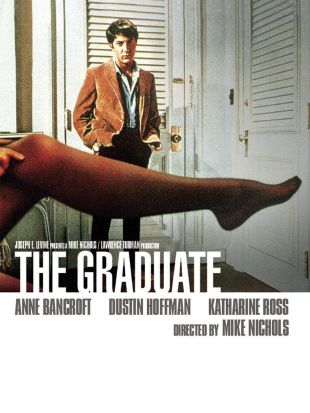A key figure in creating the look of some of Hollywood's greatest "New Wave" films, production designer Richard Sylbert collaborated with several of the period's most notable filmmakers, earning a brief, unprecedented tenure as Paramount's head of production in the process. Equally adept at period and contemporary styles, urban and rural milieus, and designs for black-and-white and color cinematography, Sylbert earned six Oscar nominations over the course of his five-decade career, winning for the distinctly different Who's Afraid of Virginia Woolf? (1966) and Dick Tracy (1990).
Born in Brooklyn, Sylbert and his identical twin brother, Paul Sylbert, fought together in the Korean War and attended Temple University's Tyler School of Art together. Returning to New York after school, both Sylberts landed TV jobs, with Richard painting scenery at NBC. After two years as the art director for TV's The Inner Sanctum, Sylbert earned his first feature-film credit with Patterns (1956). He subsequently helped create the stark, gritty feel of Elia Kazan's sexually daring drama Baby Doll (1956) and scathing TV critique A Face in the Crowd (1957). Continuing to make his name with forward-thinking directors as the studio system waned, Sylbert teamed up with independent filmmaker Shirley Clarke on her tough, innovative examination of urban junkies, The Connection (1961). Sylbert's creative range was confirmed that same year when he and Kazan envisioned the sultry Technicolor passions roiling beneath the repressed Midwestern small-town surface (via Staten Island) in Splendor in the Grass (1961). Though Splendor was his last film with Kazan, Sylbert eventually forged an equally fertile relationship with Splendor's neophyte star Warren Beatty.
Further establishing his talent for environments as steeped in psychology and fantasy as reality, Sylbert was instrumental in crafting the unsettling paranoia driving John Frankenheimer's political thriller The Manchurian Candidate (1962), punctuated by the bravura 360-degree shot blending New Jersey prattle with nefarious foreign-bred schemes. Sylbert meshed normality and madness again in Robert Rossen's Lilith (1964), while his New York locations in Sidney Lumet's The Pawnbroker (1964) spoke volumes about the eponymous Holocaust survivor's inner torment. His reputation in Hollywood was assured when Sylbert was nominated for, and won, his first Oscar for Mike Nichols' searing black-and-white adaptation of profanity-laden marital drama Who's Afraid of Virginia Woolf? Collaborating with Nichols again, Sylbert's well-appointed suburban homes, aqua-blue pool, and austerely modern church became an index of upper-middle class anomie in Nichols' seminal youth culture hit The Graduate (1967).
A fixture of the new Hollywood along with his brother, Sylbert inaugurated two more successful collaborations, with Paul's costume designer wife, Anthea Sylbert, and director Roman Polanski, on Rosemary's Baby (1968). Making the most of the New York Gothic apartment house the Dakota, Sylbert turned it into a believable roost for a Satanic coven. Between Nichols and Polanski, Sylbert worked steadily throughout the first half of the 1970s. Moving from the real/surreal accouterments of World War II for Nichols' adaptation of Catch-22 (1970), Sylbert was as comfortable creating the scientists' marine Eden for Day of the Dolphin (1973) as the more intimate landscapes of the emotionally brutal Carnal Knowledge (1971). Sylbert also managed to fit in former Nichols partner Elaine May's marital comedy The Heartbreak Kid (1972) and John Huston's rural boxing drama Fat City (1972). Sylbert finally scored his second Oscar nomination, though, for Polanski's Chinatown (1974). Filled with white buildings, dusty orange groves, dried river beds, and saline garden ponds, Sylbert's vision of 1930s Los Angeles reflected the physical and moral drought at the heart of the story's sun-drenched darkness. Evoking a different period of Los Angeles decadence, Sylbert earned his third nomination for the overdone mansions, luxe salons, and freewheeling orgies inhabited by Warren Beatty's randy 1960s hairdresser in Shampoo (1975). Paul Sylbert would win for Beatty's Heaven Can Wait (1978).
Sylbert's creative relationships and his grasp of visual storytelling led Robert Evans to make Sylbert his successor when he stepped down as Paramount's production chief in 1975. Though Sylbert's executive stint produced several hits, including The Bad News Bears (1976), his preference for such mature, challenging fare as Nashville (1975) and Days of Heaven (1978) led Paramount head Barry Diller to replace Sylbert in 1978. Back in his preferred profession, Sylbert's dedication to historical detail brought him a fourth Oscar nod for Beatty's epic John Reed biopic Reds (1981).
Despite the declining fortunes of the 1970s auteurs, Sylbert still displayed peerless style with his Oscar-nominated period designs for the Francis Ford Coppola/Robert Evans folly The Cotton Club (1984), and the 1980s New York glitz of Brian De Palma's bomb The Bonfire of the Vanities (1990). Sylbert then garnered his second Oscar for Beatty's comic strip adaptation Dick Tracy. Restricted to backlot sets, matte paintings, and the strip's seven-color palette, Sylbert masterfully created a live-action equivalent of animated fantasy. Working less frequently in the 1990s, Sylbert re-teamed with De Palma for the 1970s-set Carlito's Way (1993) and designed Hollywood New Wave cohort Bob Rafelson's neo-noir Blood and Wine (1996); Mulholland Falls (1996) was Chinatown redux. After his comically glossy matrimonial confections enhanced the Julia Roberts hit My Best Friend's Wedding (1997), Sylbert collaborated again with Wedding's P.J. Hogan on Who Shot Victor Fox? (2002). Sylbert died of cancer, though, before Fox's release.


